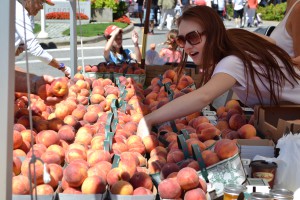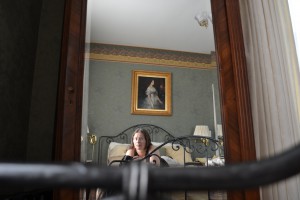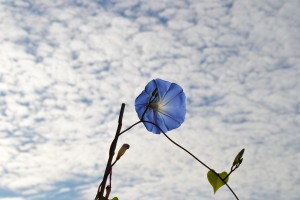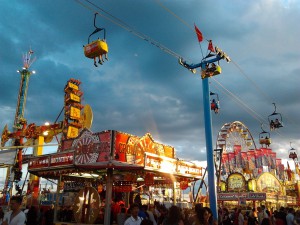I remember dreading this first-day-of-school assignment, because we did the same thing every summer. We went to the cottage, which I enjoyed on some levels, but it forced me away from my Dad and my friends, which I didn’t enjoy. I loved the daytime, being outside, swimming, lying on my grandmother’s quilts on the lawn reading comics and eating watermelon. But at night, the sheets were clammy with humidity and it was far too dark. Inevitably, I’d wake in the depths of the night, unable to see my hand in front of me, and get so scared I’d start crying. For years, all my nightmares were of being hunted by malicious forces at the cottage. Having spent months up there as an adult, I’m happy to report that the place of the cottage in my dream world has shifted to one of light.
This past summer, for the most part, I stayed in Toronto; the brief time I was at the cottage, my allergies were awful, so I avoided a prolonged stay. This summer’s highlight was certainly the band reunion, and everything leading up to and away from that.
In August, I made my annual foray to the Shaw Festival in Niagara-on-the-Lake (NOTL). I was late booking, so missed one play I wanted to see and was unable to book my usual B & B, although I did have a visit with Lynn, the owner. I had mixed feelings about my last-minute accommodations, but I enjoyed the birds’ nest behind one of the window shutters. The chatty chicks were nearly as big as their parents and beginning to venture into the huge maple a few feet away.
This year, I didn’t visit as many stores or spend much money, and I think I enjoyed NOTL even more as a result. For the first time, I was there during Peach Festival and I think that’s something I’d like to repeat. Three blocks of the main drag, Queen Street, were closed to traffic, allowing vendors to sell locally grown peaches and peach baked goods. In the evening, tables were set up along the street for gourmet dining and local wine sampling. The festival was alive with music; folk, rock, jazz, salsa—even bagpipes. The street felt very different, more relaxed, in part because I could wander back and forth as things caught my attention. The weather was fantastic, beautiful, clear and sunny. At one point, the local biker gang buzzed through town, about thirty of them, so hard not to notice. An interesting contrast. Lots of people were out enjoying the weekend; I even saw Shaw Festival actor Patrick Gallaghan out with his wife buying baked goods.
I’d intentionally left my Saturday evening free, thinking I might indulge in a gourmet meal. But I didn’t feel like it, so instead, I went on a Ghost Walk of NOTL with Lady Cassandra. This was a significant year for such a walk, as it’s the 200th anniversary of the War of 1812. For six months during 1813, the Americans occupied this small, but strategic, town, then called Newark. This summer, NOTL flew the vintage fifteen-star American flag alongside the Canadian flag, to mark the anniversary. Historically, there’s a lot of pain in this soil. When the Americans left, they razed the town, leaving about 400 residents, mostly women, children and the elderly, without shelter in December. Many froze to death. This cruel civilian attack was condemned by both the British and Americans. It also laid the course for reprisals, including the burning of the original White House. While the town was rebuilt, many lives were lost, some brutally, during the war years. And the losses didn’t end with the conclusion of that war. The room I stayed in is occasionally haunted by its former occupant, a young woman who committed suicide after her American husband was killed at the Battle of Gettysburg in the summer of 1863 during the American Civil War. Abagail reportedly doesn’t haunt romantics, so I was left in peace, however, those of you who know me well know that I’m highly impressionable when it comes to spooky stuff. I don’t do horror movies because the images haunt me for weeks or even months. Needless to say, I didn’t sleep well and yes, I had to check under the bed a couple of times because I kept getting flashes from an Evil Dead movie trailer.
And, oh yeah, I went to three plays. With the number of actor friends I have, I’m embarrassed to admit that I’d never seen the classic, Guys and Dolls. I was surprised that I knew at least half the score. Although I’d heard Bugs Bunny described as a Damon Runyon-esque character, I’d never understood the parallel until seeing this play. Wow. Talk about a culturally influential show! Peace in Our Time, a later Shaw play, wasn’t, in my opinion, one of his best. Although full of social and anti-war comment, it lacked the level of wit I generally associate with GBS. It felt very heavy handed and static. Oscar Wilde’s Lady Windermere’s Fan, on the other hand, was lovely. A thrilling satire that skewers Victorian morals, it contains such immortal lines as: “I can resist everything except temptation” and “We are all in the gutter, but some of us are looking at the stars.” I really enjoyed the acting, staging and costumes in this production. The music choices between acts were…unexpected: Velvet Underground’s “All Tomorrow’s Parties,” Rufus Wainwright’s “Art Teacher” and Katy Perry’s “Firework.” While I kind of understood the significance of the first two, the final choice seemed to overwhelm the play’s finale, but that is a minor complaint. If you want to visit Shawfest, all three plays continue into mid-October or early November.
This was the second time I took transit to NOTL and it just doesn’t work well, so I’ll probably go back to renting a car. The GO schedule doesn’t take curtain time into consideration, so play-goers may have to cab it from either St Catharines or Niagara Falls. Of course, the other advantage of a car is that I can stock up on local fruit and wine before heading back to the city.
At home, my balcony garden really took off this year. As well as violas, morning glories, marigolds, portulaca, begonias, impatiens, and sweet potato vines, I tried a gerbera daisy for the first time. It’s been sending up bright new blossoms all summer. The quality and range of floral colours have been lovely and it’s been really gratifying to have bees visiting my sixth-floor balcony. Additionally, I tried growing vegetables this year. I started them indoors from seed, probably a little late. I have about a dozen tomatoes, half-a-dozen cucumbers, and an uncertain number of peppers coming along. It was more successful than my previous attempt at a balcony vegetable garden, and I learned a few things, so plan to try again next year.
My friend James and I made our annual pilgrimage to the Canadian National Exhibition (CNE) and did some of the usual things and a few new things. We saw an intimate performance of the Flying Wallendas’ high-wire act. We missed the Super Dogs, so we checked out the miniature horses instead. We also walked through the cat show, which consisted of a variety of over-bred felines, mostly sleeping in their carriers. I was really taken with the Savannah cats, until I found out that they’re a cross between a wild serval and a domestic cat, only recently accepted as a new breed. Although a striking and affectionate cat, I don’t know why people can’t just leave wild cats alone to do what they do in their natural habitat. I was also really glad to see a large booth for Ninth Life Cat Rescue, an organization that rescues cats from death row in shelters, housing them until they can be adopted. If you’re considering feline companionship, personally, I think adopting from a shelter is a more responsible way to go. We wandered through the international pavilion, watched people on midway rides, and, after much consideration, I ate a deep fried Mars Bar, which I thoroughly enjoyed.
In other news, I completed the revised draft of Pairs & Artichoke Hearts. I got some great feedback from one of my first readers, and there’s some further work I’d like to do before sending out queries. I was also able to get back to writing my PhD dissertation; last year’s car accident did a number on my cognitive abilities, among other things, but I feel like my head is finally fully back in the game. I drove for the first time since the accident, even at night and in the rain, and nothing bad happened. I attended four funerals and a wedding, the ratio perhaps a sign of age. I did some non-academic reading, including Haruki Murakami’s 1Q84 (all 925 pages), as well as some hybrid hardboiled science fiction, and some comic books. I went to a few movies, notably Red 2, Iron Man 3, and Joss Whedon’s Much Ado About Nothing.
I took more time off than I’d intended, but the upside of that is now I’m eager to get back to schoolwork! And that’s a good thing.
© Catherine Jenkins 2013




